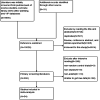Diagnostic value of neutrophil CD64, procalcitonin, and interleukin-6 in sepsis: a meta-analysis
- PMID: 33902476
- PMCID: PMC8072745
- DOI: 10.1186/s12879-021-06064-0
Diagnostic value of neutrophil CD64, procalcitonin, and interleukin-6 in sepsis: a meta-analysis
Abstract
Background: The aim of the study was to conduct a meta-analysis to evaluate the accuracy of neutrophil CD64, procalcitonin (PCT), and interleukin-6 (IL-6) as markers for the diagnosis of sepsis in adult patients.
Methods: Various databases were searched to collect published studies on the diagnosis of sepsis in adult patients using neutrophil CD64, PCT, and IL-6 levels. Utilizing the Stata SE 15.0 software, forest plots and the area under the summary receiver operating characteristic curves were drawn. The pooled sensitivity, specificity, positive likelihood ratio, negative likelihood ratio, diagnostic odds ratio, and area under the curve (AUC) were calculated.
Results: Fifty-four articles were included in the study. The pooled sensitivity, specificity, and AUC of neutrophil CD64 for the diagnosis of sepsis were 0.88 (95% confidence interval [CI], 0.81-0.92), 0.88 (95% CI, 0.83-0.91), and 0.94 (95% CI, 0.91-0.96), respectively. The pooled sensitivity, specificity, and AUC of PCT for the diagnosis of sepsis were 0.82 (95% CI, 0.78-0.85), 0.78 (95% CI, 0.74-0.82), and 0.87 (95% CI, 0.83-0.89), respectively. Subgroup analysis showed that the AUC for PCT diagnosis of intensive care unit (ICU) sepsis was 0.86 (95% CI, 0.83-0.89) and the AUC for PCT diagnosis of non-ICU sepsis was 0.82 (95% CI, 0.78-0.85). The pooled sensitivity, specificity, and AUC of IL-6 for the diagnosis of sepsis were 0.72 (95% CI, 0.65-0.78), 0.70 (95% CI, 0.62-0.76), and 0.77 (95% CI, 0.73-0.80), respectively.
Conclusions: Of the three biomarkers studied, neutrophil CD64 showed the highest diagnostic value for sepsis, followed by PCT, and IL-6. On the other hand, PCT showed a better diagnostic potential for the diagnosis of sepsis in patients with severe conditions compared with that in patients with non-severe conditions.
Keywords: Interleukin-6; Meta-analysis; Neutrophil CD64; Procalcitonin; Sepsis.
Conflict of interest statement
The authors declare that they have no competing interests.
Figures










References
-
- Rudd KE, Johnson SC, Agesa KM, Shackelford KA, Tsoi D, Kievlan DR, Colombara DV, Ikuta KS, Kissoon N, Finfer S, Fleischmann-Struzek C, Machado FR, Reinhart KK, Rowan K, Seymour CW, Watson RS, West TE, Marinho F, Hay SI, Lozano R, Lopez AD, Angus DC, Murray CJL, Naghavi M. Global, regional, and national sepsis incidence and mortality, 1990–2017: analysis for the Global Burden of Disease Study. Lancet. 2020;395(10219):200–211. doi: 10.1016/S0140-6736(19)32989-7. - DOI - PMC - PubMed
-
- Williams JM, Greenslade JH, McKenzie JV, Chu K, Brown AFT, Lipman J. Systemic inflammatory response syndrome, quick sequential organ function assessment, and organ dysfunction insights from a prospective database of ed patients with infection. Chest. 2017;151(3):586–596. doi: 10.1016/j.chest.2016.10.057. - DOI - PubMed
Publication types
MeSH terms
Substances
Grants and funding
LinkOut - more resources
Full Text Sources
Medical

